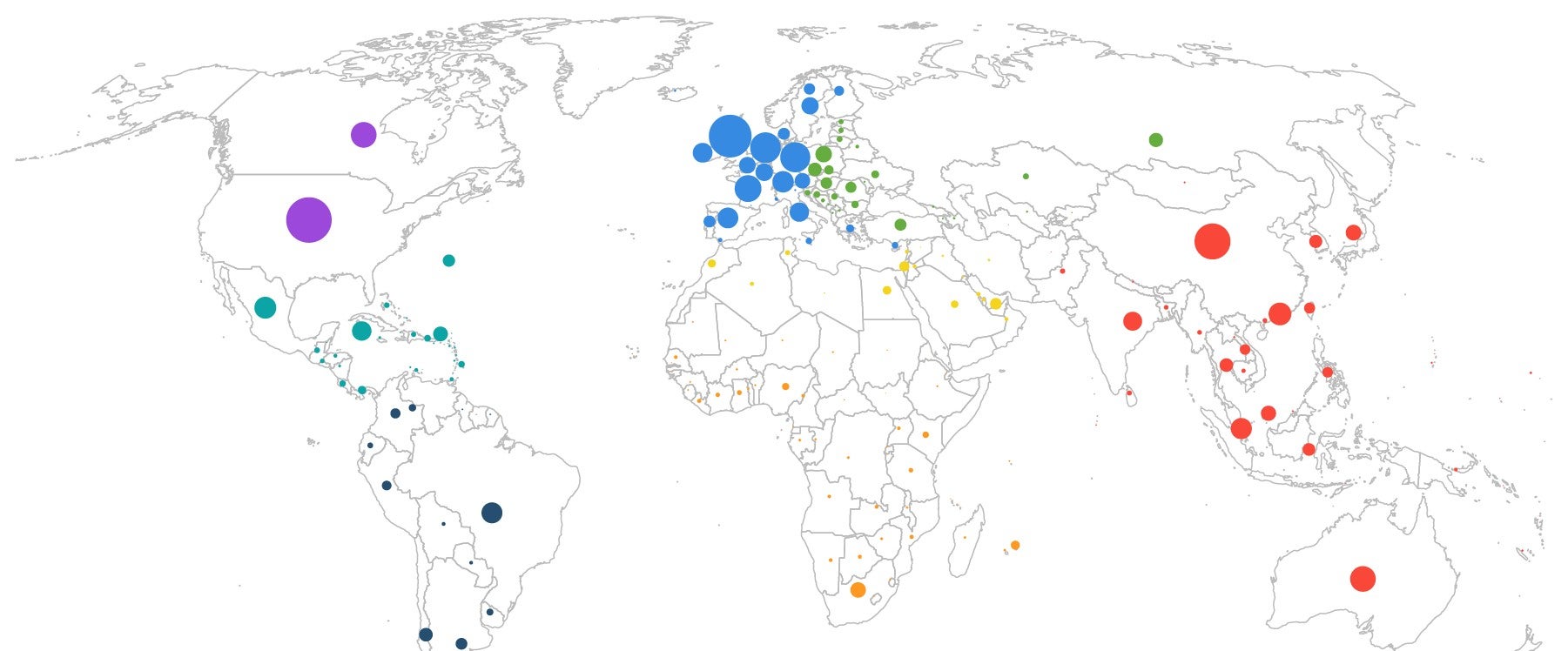
This is the 2021 version of Investment Monitor’s MNC subsidiaries database. For an updated, larger version of this map, please click here.
The establishment of subsidiaries is an important vehicle for corporate expansion activity and therefore a crucial component of cross-border as well as domestic investment. While there is much variance in how much value a subsidiary creates for its host country and how many jobs, if any, it might create, the choice of location for legal subsidiaries still tells us much about global business patterns and preferences.
Research from Investment Monitor reveals that the US remains the dominant force in both spawning and attracting subsidiaries, and that much of the activity of this nature is concentrated in the top global economies.
Using our multinational companies database, we analysed 2,188 of the top multinational companies (MNCs) by revenue, detailing how many subsidiaries they have and where they are located. In total, 216,898 subsidiaries were found. These MNCs were headquartered across 60 different countries, with one-third based in the US.
Where the MNC subsidiaries are located
A subsidiary is a company that is either owned or controlled by another company (i.e. its parent company). According to Chron.com, companies may create a subsidiary for various reasons including brand recognition, financial considerations, the ability to raise capital, and the capacity to deal with reporting and disclosure issues.
The MNCs evaluated covered 30 primary industries – the main industry in which a company operates. One-fifth of these MNCs were in the financial services industry. Technology and communications (15.5%) and construction (9.2%) were the next most popular primary industries.
Of the 2,190 companies analysed, Vinci, a French construction company, recorded the largest number of subsidiaries (2,659). Two other construction companies, Ventas and Welltower, were also listed in the top ten. Six of the top ten companies were headquartered in the US.
The mean number of subsidiaries (per company) was 99, while the mode – the most common number of subsidiaries – was 6, and the median – the middle value of the range – was 40.
Two-fifths of all companies analysed had between 11 and 50 subsidiaries.
More subsidiaries were created by construction companies (36,772) than any other industry, closely followed by financial services (35,065). Construction was also a leading industry when examining the average number of subsidiaries per company by industry. On average, 183 subsidiaries were created per leading construction MNC.
The US was the dominant destination for subsidiaries. There were 60,748 subsidiaries aligned to the top MNCs located in the country. This equated to 28% of the total number of subsidiaries. Seven of the top country destinations by number of subsidiaries are also in the top ten largest economies (by GDP) – the UK, China, Germany, France, Japan and Canada.
More of the top MNC’s subsidiaries are based in western Europe than any other world region. Just over 68,000 subsidiaries are located in western Europe, slightly more than in North America (65,172). Combined, these two regions account for 61.5% of all subsidiaries.
There were 117,834 foreign subsidiaries (54.3% of the total) created by the top MNCs. Additionally, there were 99,064 domestic subsidiaries (45.7%).
On a per company basis, top MNCs are slightly more likely to have a foreign subsidiary than a domestic subsidiary. Just over half (51.1%) of the 2,190 MNCs created more foreign subsidiaries than domestic, while 46.7% created more domestic subsidiaries than foreign entities, and 2.2% created the same number of domestic and foreign subsidiaries.
Methodology
GlobalData has compiled a list of top MNCs based on revenue. Any top companies that did not have a subsidiary were removed from the list. The latest company annual reports (2019 and 2020, where available) and websites were analysed for a total of 2,188 companies. For a subsidiary to be included, the parent company had to have a majority ownership/control in the subsidiary. Affiliates, associates, joint operations and joint ventures were included as long as the ownership criteria was met. Subsidiary information was captured at a country level. Country names were standardised. In total, 216,898 subsidiaries were captured.
The interactive graphics in this article were made by Georges Corbineau.



